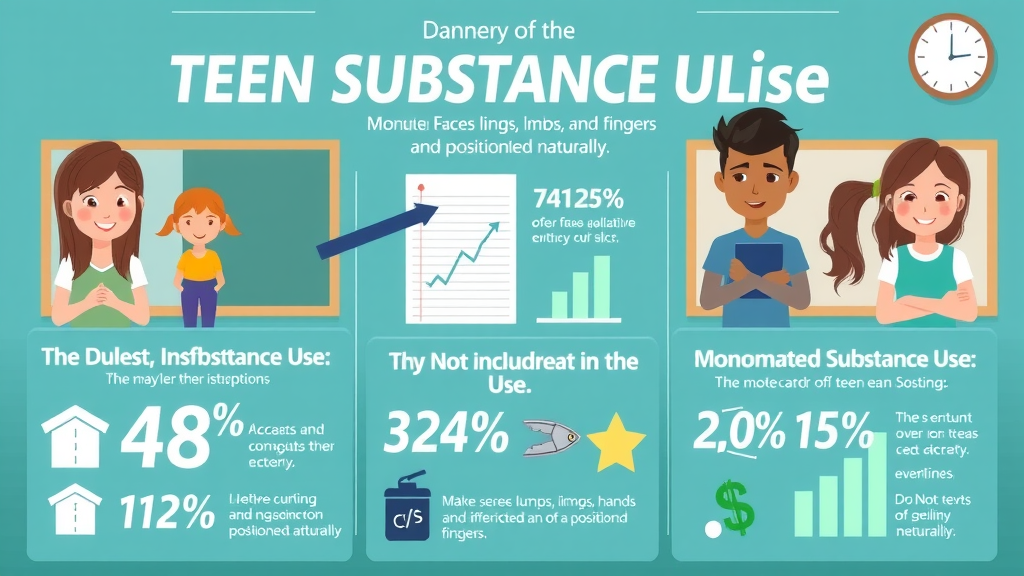Did you know that nearly 90% of teenagers report experiencing peer pressure related to substance use before they finish high school? Peer influence is not just a buzzword—it's an urgent reality driving risky decisions about alcohol and drugs among teens and emerging adults. This article uncovers the facts, busts myths, and delivers real, actionable strategies for helping youth resist negative peer pressure and substance use. Whether you’re a parent, educator, or teen yourself, these insights may be the turning point in the fight against adolescent substance abuse.
A Startling Reality: Understanding Peer Pressure and Substance Use Among Teens
Peer pressure and substance use are deeply intertwined for today’s teenagers. Increasingly, studies reveal that teens face not only the traditional pressures from close friends but also the added influence of social media and wider peer groups. According to recent research, the average age of first experimentation with alcohol or drugs continues to drop, and peer influence has a significant impact on these choices.
In high school hallways, at after-school hangouts, and throughout online spaces, young people witness both direct and indirect encouragement to try alcohol, drugs, or vaping. While peer pressure isn’t always overt—sometimes it’s a subtle nudge or the normalization of risky behaviors—it remains one of the strongest risk factors for adolescent substance use disorder. And when we add the voice of social media, teens encounter a pressure group that never truly turns off, amplifying both positive and negative expectations. Recognizing this landscape is the first step toward creating strategies that help teens confidently say no to substance abuse.

Peer Pressure and Substance Use: Fact Versus Assumption
“Nearly 90% of teenagers report having experienced peer pressure related to substance use before graduating high school.”
It’s tempting to believe that peer pressure is only an occasional challenge. However, teen substance abuse is often rooted in persistent, daily social pressures. Research consistently shows that both the perception and reality of peer substance use can dramatically influence a teen's decision-making. In environments where drug and alcohol use seem common—even if exaggerated—teens are far more likely to try risky substances themselves. This means that perceived peer pressure may be as powerful as actual direct encouragement, especially as teens navigate the stressful journey towards adulthood.
Yet not all peer influences lead to negative outcomes. Understanding the nuances between peer pressure group dynamics, direct negative peer pressure, and supportive friendships is essential. Sometimes, healthy support groups and positive peer models set norms that encourage avoidance of alcohol and drugs. The challenge for families and educators is distinguishing between risk and resilience—and finding ways to empower teens no matter which pressure they face.
What You'll Learn About Peer Pressure and Substance Use
The definitions and types of peer pressure
How social media amplifies peer influence on substance use
Why teens and emerging adults are especially vulnerable
Strategies for resisting negative peer pressure and substance abuse
Expert opinions on supporting teens

Defining Peer Pressure and Substance Use: Key Terms and Concepts
Term |
Definition |
|---|---|
Peer Pressure |
The influence exerted by a peer group that encourages individuals to change attitudes, values, or behaviors to conform to group norms, often impacting decisions about drugs and alcohol. |
Substance Abuse |
The harmful or hazardous use of psychoactive substances, including alcohol and illicit drugs, which can lead to substance use disorders and lasting health consequences. |
Peer Influence |
The effect that a peer group or individual peers have over others, shaping beliefs, decisions, and actions—either toward positive or negative outcomes. |
Emerging Adulthood |
A developmental stage (late teens through mid-twenties) marked by increased peer interaction, identity exploration, and higher risk for substance experimentation and abuse. |
Types of Peer Pressure: Positive and Negative Influences on Substance Use
Direct versus indirect peer pressure
Negative peer pressure and substance abuse risk
Positive peer influences and healthy choices
Peer pressure manifests in several forms. Direct peer pressure involves explicit offers or encouragement to try drugs or alcohol, while indirect peer pressure works more subtly—unspoken expectations, observing others’ choices, or simply wanting to belong. It's this silent yet powerful peer influence found in social settings, extracurricular groups, and even on social media, that often catches teens and emerging adults off guard.
On the flip side, positive peer pressure exists as well. Groups that celebrate healthy choices, prioritize academic achievement, or model resilience play an important role in decreasing the risk factor for negative behaviors and substance use disorder. Positive and negative pressures coexist in adolescent and emerging adulthood cultures—making it essential to differentiate and reinforce the former while tactfully navigating the latter. Parents, mentors, and educators can harness positive peer groups to counteract the dangers of negative peer pressure and substance use risk.
How Social Media Shapes Peer Influence and Substance Use Behavior
Social media platforms like Instagram, Snapchat, and TikTok have changed the way peer influence operates. Online, teens aren’t just exposed to their immediate circle—they’re served a constant stream of peers, celebrities, and influencers showcasing an often-glamorized lifestyle, including alcohol or drug use. Research reveals that exposure to such content is now considered a significant risk factor for adolescent substance abuse, as it normalizes and even incentivizes risky behavior.
The interactive and viral nature of social media drives home the message that substance use is a common or “cool” activity, making it harder for teens to resist pressures. Shared images, videos, and stories often blur the line between reality and aspiration, pushing young viewers to mimic behaviors for acceptance or online popularity. This influence is amplified during emerging adulthood, when seeking approval is central to one’s social and emotional development.
Social Media, Peer Pressure and Substance Use: A Modern Epidemic?
“Images and stories on social media can both glamorize substance use and perpetuate unrealistic social norms.”
When teens perceive that “everyone’s doing it,” whether through carefully curated images or viral trends, the weight of perceived peer pressure grows heavier. This can be particularly damaging for those who already struggle with self-esteem or are transitioning through challenging periods of mental health. As parents and educators, it is vital to teach youth the difference between online fiction and reality, and to provide tools for healthy media literacy. Setting boundaries around social media use is not just about screen time—but about building resilience against powerful peer pressure and substance use cues.
Families and communities can combat this by promoting positive and negative social media messages—using platforms to share stories of sobriety, resilience, and real-life consequences. Encouraging teens to follow inspirational and health-focused accounts can mitigate some of the negative peer pressure group dynamics online. Through honest conversations and community support, the cycle of glamorized substance abuse on social networks can be broken.

The Psychology of Peer Pressure and Substance Use in Emerging Adulthood
Adolescence and emerging adulthood represent unique times in brain development and social-emotional growth, making them highly susceptible to peer pressure and substance abuse. The prefrontal cortex—the part of the brain responsible for impulse control and sound decision-making—is still maturing well into the mid-twenties. During this phase, peer acceptance and social success weigh more heavily than ever before, often overshadowing long-term risks of alcohol or drug abuse.
This heightened vulnerability means that exposure to drug and alcohol use in peer groups or through social media can lead directly to experimentation, substance use disorder, or even lifelong mental health impacts. Social belonging is a powerful motivator in emerging adults; being accepted by peers often feels more immediately important than the warnings of parents or educators. That’s why understanding the underlying psychology—and reinforcing supportive relationships—matters so much in preventing adolescent substance abuse.
How Brain Development and Social Needs Heightsen Substance Use Risk
Vulnerability in emerging adults
Substance use disorders and lasting impacts
Influence of friends and social dynamics
During the teen years and into early adulthood, brain circuits related to pleasure, reward, and risk-taking are in overdrive. Emerging adults crave excitement, peer approval, and new experiences. When placed in situations where alcohol or drug use is being normalized or encouraged, these neurological factors, combined with social pressure, create a perfect storm for substance use disorders.
Many studies from organizations like the National Institute on Drug Abuse show a clear link between peer-led environments and both initial experimentation and persistent substance use. Further, once a substance use disorder is established in adolescence or early adulthood, its effects can ripple through physical health, academic success, and even adult mental health. The role of positive peer influences and close adult relationships cannot be understated in breaking this cycle.
Why Teens Give Into Peer Pressure and Abuse Drugs: An Opinion Analysis
One of the most frustrating realities for parents and teachers is watching teens with otherwise good decision-making skills suddenly make risky choices around peers. Why does this happen? The desire for acceptance in a peer pressure group, the need for autonomy, and the struggle to cope with stress or mental health challenges are all contributors. In our opinion, negative peer influence is often compounded by a lack of practical coping skills, making substance use appear as a viable solution—or even a rite of passage.
The culture of “fitting in” has shifted from physical peer groups to include digital circles, intensifying the perceived threat of exclusion. As teens grapple with academic pressure, changing social dynamics, and constant online comparisons, substance abuse becomes one misguided way to fit in or cope. Addressing this requires a shift in conversation: from focusing on punishment, to fostering understanding and equipping teens with tools for resilience.
Root Causes: Negative Peer and Environmental Pressures
“The absence of adequate coping strategies is why many teens succumb to negative peer pressure and substance use.”
Environmental challenges—from unstable family dynamics to high academic or social stress—can push teens towards groups that provide acceptance, even if those groups normalize substance use. Negative peer pressure is especially persuasive when combined with a teen’s existing vulnerabilities or when positive adult role models are absent. The most effective prevention strategies go beyond simply saying “no”—they help young people build emotional intelligence, self-confidence, and real-life coping skills to handle stress and rejection. Encouraging healthy activities, promoting strong peer connections, and modeling open communication are all part of a whole-child approach.
Ultimately, empowering emerging adults to make healthy choices requires a multifaceted approach, one that identifies both the roots of negative peer influence and the unique strengths of each individual. Understanding the underlying reasons why some teens are drawn to drugs or alcohol—and intervening early—can dramatically reduce the long-term risks of substance use disorder and adolescent substance abuse.
Recognizing Warning Signs of Substance Use and Negative Peer Pressure
Behavioral changes
Shifts in academic performance
New or secretive friend groups
Physical health warnings
Recognizing when a teen is struggling with negative peer pressure or early substance use can be challenging, as the warning signs often resemble typical teenage behavior. However, consistent or dramatic behavioral changes—such as mood swings, irritability, increased secrecy, or withdrawal from family—should raise red flags. Shifts in academic performance, like sudden drops in grades or loss of motivation, often occur in parallel with increased substance use or involvement with at-risk peer groups.
Teens experimenting with drugs or alcohol may also start associating with new, sometimes older, friends and avoid conversations with trusted adults. Physical warning signs such as bloodshot eyes, changes in sleep patterns, and unexplained health complaints are important clues for parents and caregivers. Early intervention, built on open communication and non-judgmental support, can make all the difference in redirecting a teen away from negative peer pressure and substance cruelty.

Expert Strategies to Help Kids Resist Peer Pressure and Substance Use
Building a strong foundation for teens to resist negative peer influence starts with supportive adults and proactive education. Experts in adolescent substance abuse prevention emphasize the power of role play, positive reinforcement, and the modeling of healthy boundaries. Open, honest communication between parents and children is the cornerstone of prevention, helping teens feel secure voicing their concerns, fears, or questions about drugs and alcohol without shame.
Setting clear expectations around substance use, consistently reinforcing family values, and providing real-life examples of positive peer pressure are proven strategies for prevention. Supportive adults, such as teachers, mentors, or coaches, can also play an important role in helping teens build the confidence and skills necessary to say no—even in challenging social environments. Ongoing conversations about social media and peer influence can further reduce the risk of substance abuse, especially in emerging adulthood.
Open Communication and Parental Modeling as Key Defenses
Role-playing scenarios
Supporting positive peer influence
Enforcing boundaries and consequences
One of the best ways to prepare teens for real-life scenarios is through role-play. Practicing different responses to peer offers, brainstorming what to say, and even acting out awkward situations can help remove the fear of saying “no.” Families that encourage positive peer influence and nurture connections with healthy peer pressure groups set a powerful example. Modeling refusal skills, maintaining clear boundaries, and consistently reinforcing consequences for substance use are essential—not just as discipline, but as life lessons in responsibility.
Just as importantly, parents and mentors must openly discuss their own values and decisions regarding drugs and alcohol. When teens see adults navigate peer influence and stress in healthy ways, they’re more likely to emulate those strategies. Creating a climate of trust—where teens feel comfortable bringing up challenging topics—builds resilience against both negative peer pressure and the ever-present risks of social media-driven substance use.

Real Stories: Teens Overcoming Peer Influence and Substance Abuse
The most compelling lessons come from those who have faced and resisted negative peer pressure. Stories of emerging adults who chose sobriety, sought out positive peer groups, or recovered from substance use disorder remind us that change is always possible. Hearing real accounts from teens who trusted mentors, joined treatment programs, or simply found the strength to say “no thanks” can be an invaluable deterrent for others struggling to resist.
Communities that prioritize sharing success stories create new norms—redefining what it means to be “cool.” They also break down the stigma of seeking help, encouraging young people at risk to reach out before substance abuse spirals out of control. As more teens see their peers overcoming challenges and reclaiming healthy futures, hope expands for every member of their peer pressure group.
Emerging Adults Speak—Perspectives on Peer Pressure and Substance Use
“Hearing stories from peers is one of the most powerful deterrents to negative peer pressure.”
Young people are more likely to listen to—and be inspired by—their own peers than by adults. Whether through school assemblies, online forums, or informal conversations, sharing firsthand perspectives on resisting drugs and alcohol can counter misinformation and dismantle the glamorization of substance abuse. Promoting open dialogue, peer mentorship, and community support networks turns awareness into action, and action into lifelong resilience.
As the emerging adult community shares stories of perseverance and achievement, the narrative around peer pressure and substance use shifts from risk and fear to possibility and hope. These real voices are the foundation of cultural change.
People Also Ask: Key Questions About Peer Pressure and Substance Use
What is peer pressure with substance use?
Peer pressure with substance use refers to the influence exerted by peers or social groups that encourages individuals—especially teens and emerging adults—to try alcohol, drugs, or other substances, often against their better judgment. This can be direct or indirect and is a leading risk factor for adolescent substance abuse.
Why do some teens give into peer pressure and abuse drugs?
Many teens give into negative peer pressure because of the desire for acceptance, fear of social exclusion, curiosity, or a lack of alternative coping mechanisms, making them susceptible to substance abuse. Without healthy outlets or support, this vulnerability may lead to early experimentation and substance use disorders.
How does peer pressure influence alcohol use?
Peer pressure can strongly influence alcohol use through direct offers, modeling of drinking behavior, or the normalization of substance use in social groups and on social media. Seeing peers engage in binge drinking or other risky behavior often lowers inhibitions and increases the temptation to participate.
What kinds of peer pressure are likely to most strongly influence his or her decisions about substance abuse?
Direct, persistent, and negative peer pressure—such as repeated offers of drugs or alcohol, or threats of exclusion—are most likely to influence substance use decisions, especially when combined with social media reinforcement. Teens whose friends or peer group normalize and encourage risky behaviors are at the highest risk.
Practical Tips: Helping Teens Say No to Peer Pressure and Substance Use
Practice refusal skills with role play
Teach the consequences of substance abuse
Encourage involvement in substance-free activities
Promote positive friendships
Monitor and talk about social media use
Each of these steps reinforces the confidence needed to withstand negative peer influence. Whether through home discussions, school programs, or community activities, teens benefit most when trusted adults take an active role in practicing and modeling these skills. Focusing on strengths, providing alternatives, and encouraging authentic friendships are all part of a holistic approach to substance abuse prevention.
When teens know how to say no, understand the consequences, and feel safe discussing peer pressure fears, they are far less likely to succumb to negative influences. It’s not just about one conversation—it’s a series of ongoing actions that form a safety net around young people.

Key Takeaways: Peer Pressure and Substance Use Prevention
Peer pressure is a potent factor in teen substance use
Social media amplifies peer influence among emerging adults
Empowering teens with knowledge, skills, and support reduces risk
Open, honest communication with a trusted adult is vital
Frequently Asked Questions: Peer Pressure, Substance Use, and Prevention
What strategies are most effective in preventing teen substance use?
The most effective strategies include fostering open parent-child communication, role-playing scenarios to practice refusal, supporting positive peer connections, providing engaging alternatives to substance use, and modeling healthy behaviors as adults. Early and ongoing education about the risks and realities of substance abuse is also key.
How can parents talk to children about negative peer pressure?
Parents can start by building trust and inviting honest discussion. Ask open-ended questions about school, friends, and social influences, listen without judgment, and share personal experiences or stories. Help children think through various scenarios, practice assertive communication, and assure them they can always come to you for support or advice.
What are the long-term effects of substance use disorders beginning in adolescence?
Substance use disorders starting in adolescence can lead to long-lasting effects on mental health, academic achievement, relationships, and overall well-being. They increase the risk of chronic health issues, legal problems, and addiction well into adulthood. Early intervention is essential to minimize these risks and promote lifelong health.
Conclusion: Shifting the Conversation on Peer Pressure and Substance Use
Combatting peer pressure and substance use among teens demands open dialogue, evidence-based strategies, and the courage to challenge social norms. Every parent, educator, and peer can help create a supportive environment that empowers youth to make healthy choices.
Call to Action: Take the First Step in Supporting Teens Against Peer Pressure and Substance Use
Start the conversation today—be the support system your child or student needs to confidently say no to negative peer influence and substance abuse.
 Add Row
Add Row  Add
Add 





Write A Comment